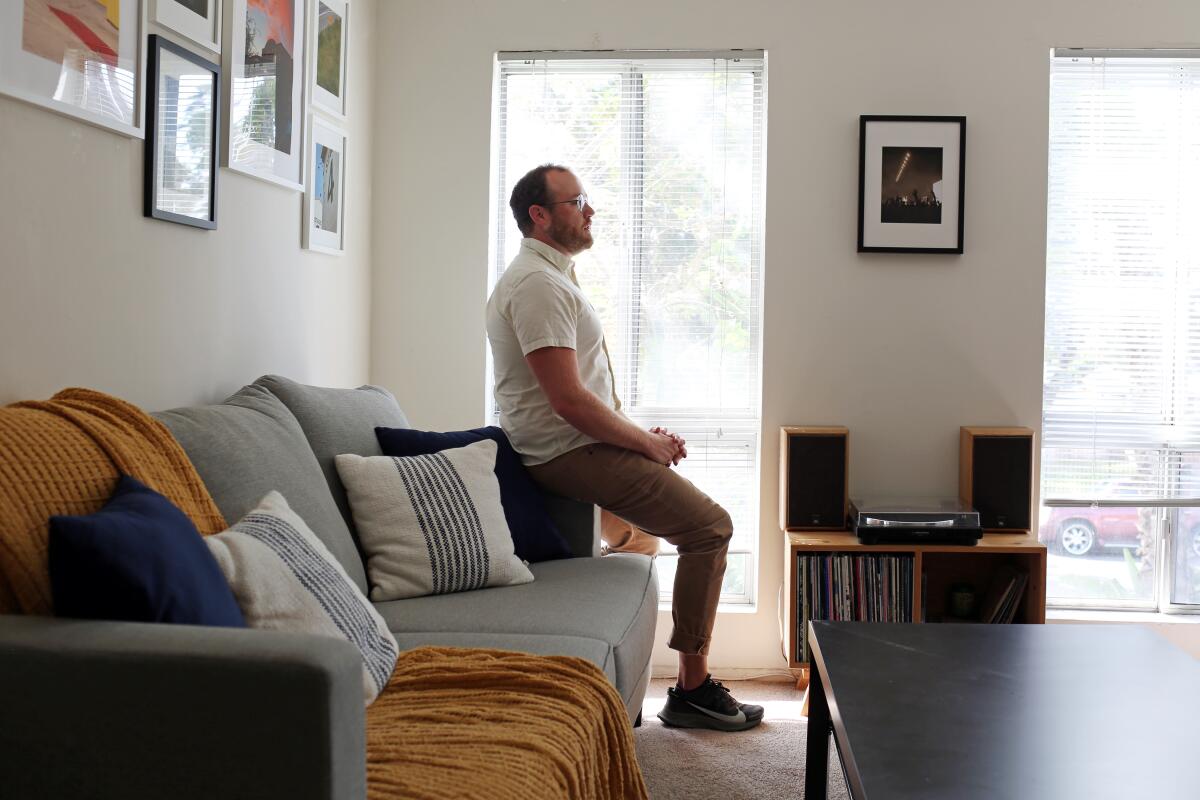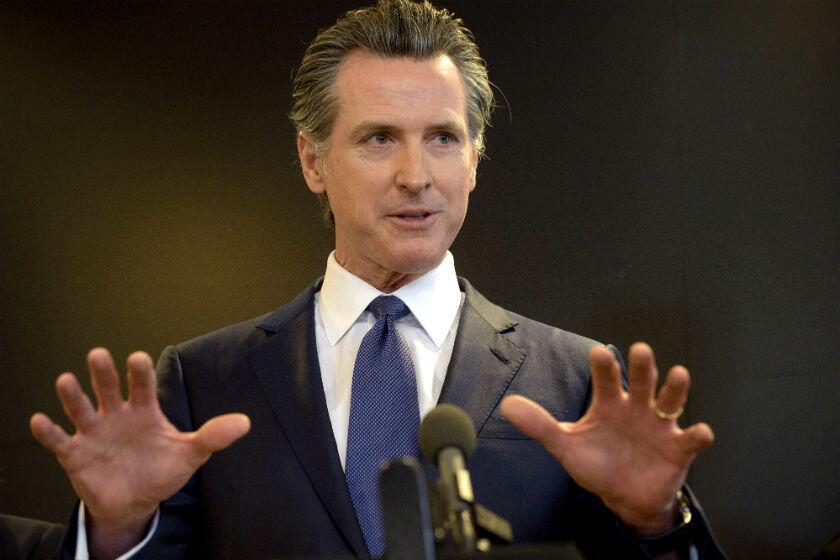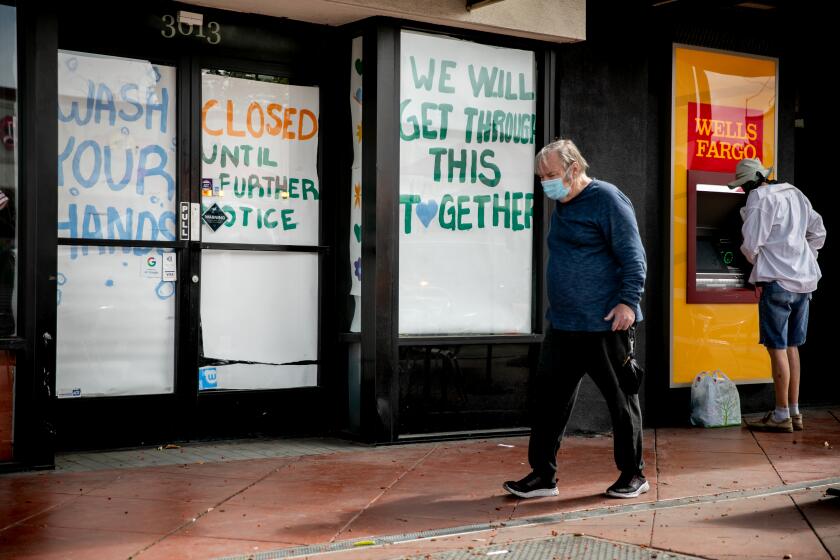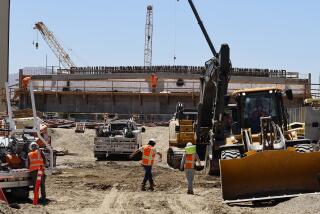California is ‘clawing back’ from pandemic recession. But some have quit the job hunt

- Share via
California’s economy is slowly picking up as businesses reopen and new unemployment claims fall, but stubborn joblessness persists as many simply stop looking for work.
In March, employers added 119,600 positions, state officials reported Friday. The Golden State has yet to recover 56% of the 2.7 million jobs lost due to the COVID-19 pandemic last spring.
California’s unemployment rate dropped to 8.3% in March from 8.5% a month earlier but remained far higher than the 4.5% in March 2020, before the virus took hold. And last month’s slide was mainly caused by nearly 40,000 workers quitting the labor force, economists said.
The state’s economy is recovering more slowly than the nation’s as officials have been more cautious in lifting restrictions on businesses than in other states. After New York and Hawaii, California unemployment was the third-highest in the nation, tied with New Mexico. The U.S. jobless rate stood at 6% in March.
“California is clawing back some of the huge job losses suffered during the pandemic, but much progress remains to be achieved,” said Lynn Reaser, an economist at San Diego’s Point Loma Nazarene University.
Many people lost jobs, got hours cut, or stopped looking for work in the past year. We’d like to hear about your experiences and your plans moving forward.
Payrolls nationally were 5.5% below pre-pandemic levels, compared with California’s 8.6% drop.
Along with its more restrictive policies to contain the virus, the state’s greater dependence on tourism has devastated its hotel, convention, restaurant and live entertainment industries and accounts for much of the difference with the broader U.S. recovery, Reaser said.
“Many people have either quit their jobs or stopped looking for work,” she said. “Some needed to care for children and for parents. Some feared becoming infected at work. Some despaired at finding a job and opted for unemployment benefits. Still others have simply burned out.”
Ian McFarland, a 33-year-old video editor and aspiring screenwriter, was laid off from a small Los Angeles production company in mid-March last year as the coronavirus began to spread.
“I’m a college graduate with years of experience who interviews well and I still haven’t found a job after looking for 12 months,” he said. “There are just too many people trying to find work in my industry.”
Thanks to a rent-controlled apartment, unemployment benefits and federal stimulus payments, McFarland’s income has been slightly above what he was earning in his minimum-wage job, he said.
But the job hunt remains discouraging. After moving to California seven years ago to build a career in the entertainment industry, “I may need to switch industries,” he said. “I may even have to move back home to Kansas City.”
Although the entertainment industry is recovering more slowly than several other sectors, the state’s overall economy is showing encouraging signs since the March jobs numbers, which are collected mid-month.
There are just too many people trying to find work in my industry.
— Ian McFarland
Since early April, with the pace of vaccinations accelerating, many California counties have emerged from the most restrictive tiers that regulate business closures, and the number of newly unemployed workers filing for benefits is dropping sharply.
For the week ending April 10, new jobless claims totaled 91,756, the lowest level since the pre-pandemic week ending March 14, 2020, and a sharp decrease from the previous week’s total of 169,902.
“That’s the strongest sign so far of the start of an employment recovery,” said Michael Bernick, a former director of the state’s Employment Development Department. “It’s rooted in the combination of widespread vaccinations, schools reopening and the economic lockdowns being lifted.”
The wealthy state is failing many of its workers, a report commissioned by Gov. Gavin Newsom says, highlighting how California continues to grapple with a starkly unequal economy. It calls for “moonshot goals,” including guaranteed jobs for all Californians who want them.
The March report showed a broad recovery with payrolls expanding across 10 of the state’s 11 industry sectors. Leisure and hospitality businesses such as restaurants, bars, entertainment and hotels accounted for 42,400 new jobs, more than a third of last month’s gains.
Trade, transportation and utilities, which include retail stores and e-commerce warehouses, saw the second-highest jump with 32,200 new jobs.
Other recovering sectors: professional and business services, which include jobs ranging from low-wage office clerks to well-paid lawyers and executives (22,000); the “other services” sector such as hair salons and auto repair shops (7,300); and construction (6,000).
The only sector to shrink in March was financial activities, which lost 600 jobs.
Earlier this month, Gov. Gavin Newsom announced the state can expect to fully reopen its economy by June 15 assuming Californians continue to wear masks, hospitalizations diminish, more Californians are vaccinated and contagious variants of the virus are controlled.
“Stars are aligned right for a strong job recovery in the state,” said Sung Won Sohn, a business economist at Loyola Marymount University. Yet it could take years for employment to return to peak levels before the pandemic, he said: “Many of the jobs won’t come back at all. Many small businesses have closed permanently.”
A California bill would create BankCal, offering free financial services to the “unbanked” and “underbanked,” whose low wages often are eaten up by high fees
In Los Angeles County, the unemployment rate remained high in March, at 11.3%, a slight drop from February’s 11.5%, due in part to 12,000 workers who stopped looking for work.
Countywide, 579,000 workers were counted as unemployed.
L.A. County added 34,200 jobs in March for a total of about 4.1 million, with leisure and hospitality posting the largest gain of 13,300 positions.
In Orange County, the March unemployment rate was 6.4%, down from 6.7% in February. The county gained 17,800 jobs for a total of about 1.52 million. Leisure and hospitality businesses added 9,800 positions, the most of any sector.
In the Inland Empire, which encompasses Riverside and San Bernardino counties, the March unemployment rate was 7.7%, down from 8.1% in February. The region added 12,500 jobs, with leisure and hospitality, up by 4,900, accounting for the largest increase.
In Northern California, buoyed by a tech economy in which many were able to work from home, unemployment in March stood at 5.4% in San Francisco County, 5.1% in Santa Clara County and 5% in San Mateo County.
“Today’s jobs report is another marker of how far we’ve come together — and of how much work we still have to do,” Dee Dee Myers, director of the Governor’s Office of Business and Economic Development, and California Labor Secretary Julie Su said in a joint statement. “It is on us as Californians to continue to do our part, wearing masks and observing other common-sense health protocols so that all sectors of our economy can recover.”
The monthly payroll report is based on a federal survey of 80,000 California businesses. The unemployment rate comes from a separate federal survey of 5,100 California households.
More to Read
Inside the business of entertainment
The Wide Shot brings you news, analysis and insights on everything from streaming wars to production — and what it all means for the future.
You may occasionally receive promotional content from the Los Angeles Times.














